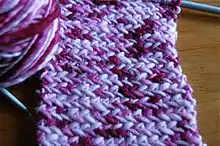Herringbone stitch
A herringbone stitch is a needlework stitch used in embroidery, knitting and crochet. It is so named as it resembles the bones extending from the spine of a herring fish. In knitting, it is a stitch that creates a fabric pattern closely resembling a herringbone pattern, or herringbone cloth.


A knitted herringbone stitch creates a firm fabric "similar to a woven in appearance and elasticity".[1] A heavyweight fabric can be made with variations of the herringbone stitch, such as the herringbone twist stitch, which can be worked in either one or two colours; both versions are suitable for experienced knitters.[2]
Cultural symbolism
The herringbone stitch is used as one of the symbolic motifs in the traditional knitted Aran jumper, or "fisherman's sweater"; specifically, the tradition as it exists in the Channel Islands of Guernsey, Jersey and Filey. The herringbone pattern represents the "fisherman's catch and thus for success in one's career".[3]
See also
| Wikimedia Commons has media related to Herringbone stitch. |
References
- Virginia Colton, ed. (1979). Reader's Digest Complete Guide to Needlework. Montreal: The Reader's Digest Association Canada. pp. 301. ISBN 0888500858.
- The Ultimate Source Book of Knitting and Crochet Stitches. Collins & Brown Limited; The Reader's Digest Association. 2003. p. 96. ISBN 0762104058.
- Domnick, Sabine (2007). Cables, Diamonds, Herringbone: Secrets of Knitting Traditional Fishermen's Sweaters. Down East Books. pp. 53, 71. ISBN 9780892726882.